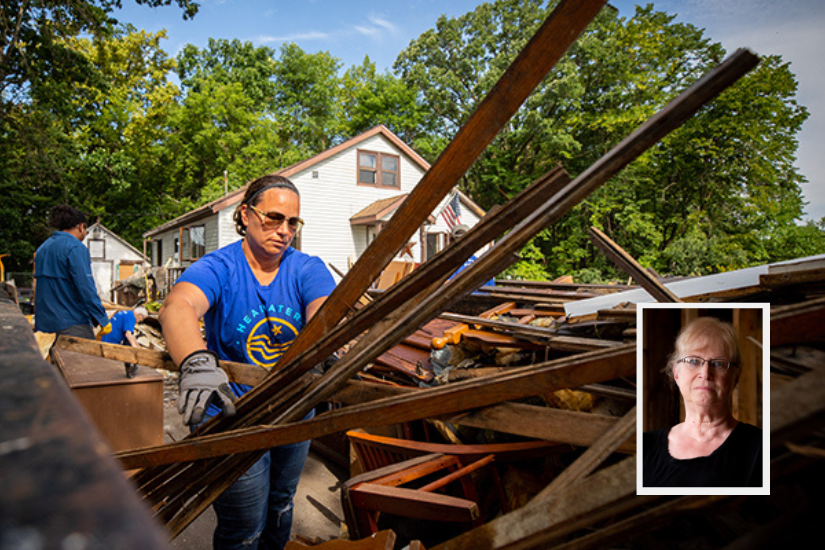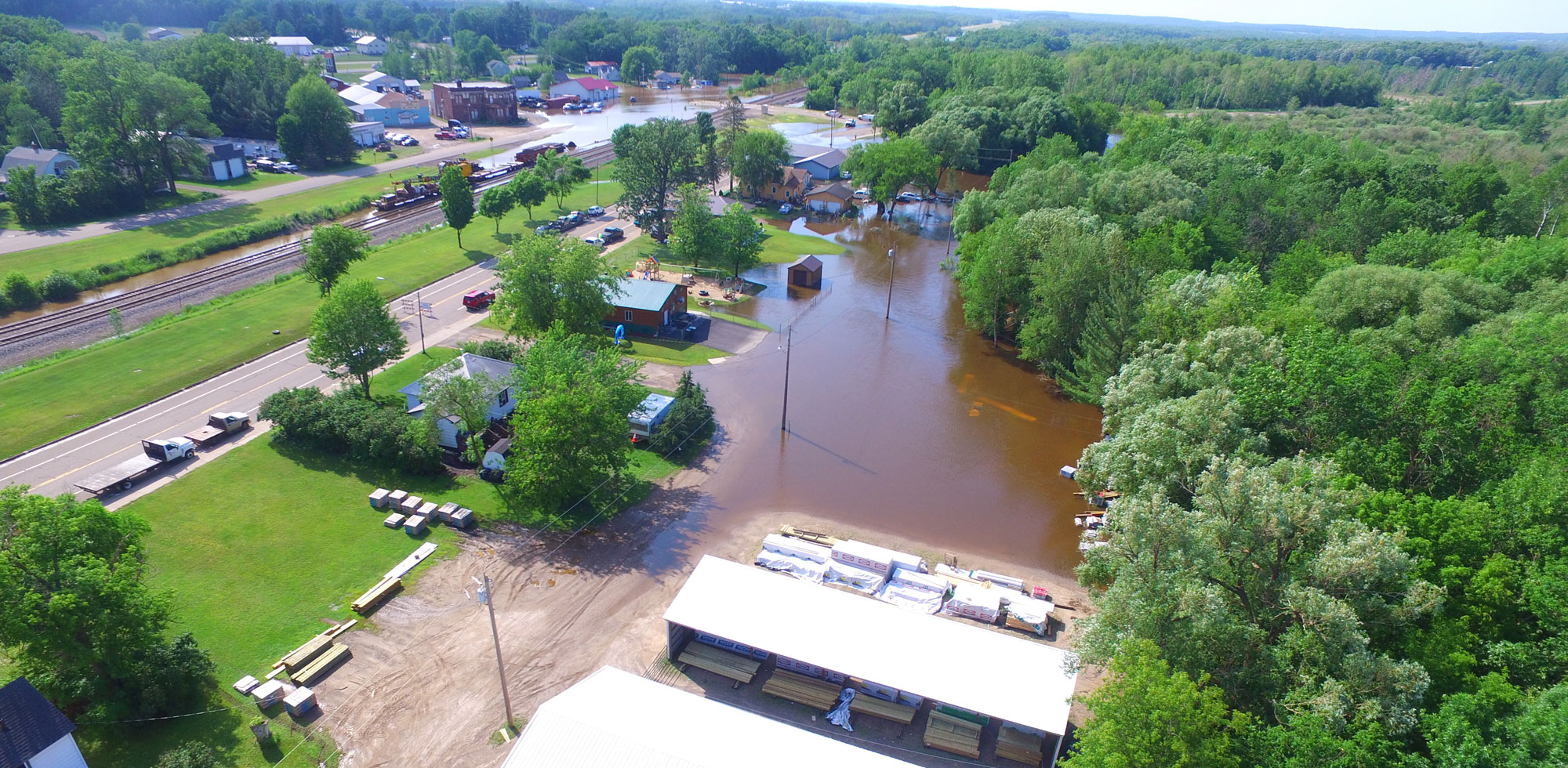
Rallying Around Randall
When disasters strike, long-term support is key to community recovery
By Suzy Frisch | Photography by Zack Swanson
Patricia Ganz was at work early the morning of June 24 when she got an ominous phone call: a deluge of rain had poured into her Randall home. When she arrived at her house at 7 a.m., the situation was worse than she expected. About 3 to 4 feet of water had inundated her home. Furniture was floating in the muddy water, and the freezer in her garage had been toppled and pitched on its side. Ganz and her family lost everything.
“It happened so fast—in half an hour the place was just flooded. We don’t know yet whether it can be repaired,” said Ganz, who lives in the three-bedroom home with her granddaughter, son, and her son’s girlfriend. The house currently is uninhabitable with the walls stripped down to the studs, the flooring removed, appliances ruined, and the furnace out of commission. To top it off, Ganz—like many of her neighbors—lacked flood insurance, so she is getting no help from her insurance company.
Misery was widespread in Randall, located in Morrison County, with damages ranging into the millions of dollars. A slow-moving storm pelted the area with 12.3 inches of rain, damaging 32 homes and flooding several businesses and nonprofits. Many residents were trapped in their homes and had to be rescued by boat in the middle of the night. Water from the overflowing Little Elk River kept roads underwater for days, while Randall’s water treatment plant was flooded and shut down for health and safety concerns.
LONG-TERM HELP
Volunteers, nonprofits and government agencies rushed to help. They provided immediate aid in the form of food, shelter, clean-up and supplies for residents to regain some normalcy in their lives. Such assistance is vital in helping communities meet critical needs right after a flood, fire, tornado or other disaster.
Yet, it’s often what happens in the weeks and months after the initial emergency that plays a key role in getting a community back on its feet. “It’s a universal pattern that two weeks after a natural disaster, communities are truly beginning to pick up the pieces and start to get discouraged when they recognize that it will take a very long commitment to fully recover,” said Don Hickman, vice president for community and workforce development at the Initiative Foundation.
To help Randall move from disaster response to long-term recovery, a public-private partnership got busy. It involved the city of Randall, county agencies, and entities like the Minnesota Rural Water Association and the Minnesota Pollution Control Agency. They worked to make sure the region had access to clean water and functioning sanitary sewer, natural gas and electrical systems, said Matt Pantzke, Randall city manager. The Small Business Administration also offered low-interest loans for home repairs to affected residents.
Funding always plays a crucial role, and even more so in rural areas. That’s why the Initiative Foundation aligned with The Funders Network and its Philanthropic Preparedness, Resiliency and Emergency Partnership to spearhead comprehensive fundraising to help communities like Randall. Ongoing support is needed, particularly in rural areas, when smaller-scale disasters strike. News of the events circulate and then quickly disappear from the headlines, Hickman said, and the affected areas often lack the resources to engage the public for assistance over long periods of time.
In smaller towns, it’s especially vital to achieve a full recovery because communities want to ensure people stay put after a natural disaster. “At a time when every business in Minnesota is looking for workers and every rural community in Central Minnesota does not want to lose population, everyone is an asset,” Hickman said. “It’s hard not to get discouraged and feel like you don’t have support.”

12.3 inches of rain. The deluge caused the Little Elk River to overflow its
banks, damaging 32 homes and flooding several businesses and nonprofits.
Photos courtesy of the Morrison County Sheriff’s Office.
FULL-ON FUNDRAISING
To show support for the community, the Initiative Foundation instigated deep and wide fundraising efforts. It put up a $10,000 challenge grant and attracted donations big and small, including $10,000 from Compeer Financial to support Randall’s damaged small businesses. Donations topped out at nearly $120,000, thanks to $55,000 from the Funders Network, $30,000 from the Greater Lakes Association of Realtors, $12,000 from a community fundraiser at the Falls Ballroom, and contributions from individuals, businesses and nonprofits.
Having the Initiative Foundation support fundraising and behind-the-scenes administration is important because it assures donors that their funds go where they are needed most, said Kate Bjorge, community philanthropy manager for the Foundation. The Initiative Foundation set up an online fundraiser, partnered with Randall State Bank to house the funds, and put in place a mechanism to provide people with receipts for their charitable tax deductions.
Next, in partnership with entities like Lutheran Social Services and St. James Catholic Church, the Foundation created the Randall Area Flood Recovery Fund Task Force to determine how to distribute the donations. “The role we bring in fundraising is we can organize it, track those funds, and disburse them in an organized way that meets every legal requirement,” Bjorge said. “We’re grateful for partners like Lutheran Social Services and the Little Falls Area Ministerial Association for their help with case management and their quick efforts to equitably disburse funds to those in need.”
Individuals and nonprofits in Randall in need of assistance filled out applications describing their circumstances, which included dead appliances and major structural damage to finished basements ruined by 4 to 5 feet of water. Another factor included whether people had insurance or enough insurance. The task force used a point system to score each application, which did not have identifying information. The more significantly damaged homes received higher points—and therefore more financial support.
This system gave peace of mind to Randall Area Flood Recovery Fund Task Force member Al Poser, who serves on the St. James Catholic Church parish council and its finance committee. “I was a little nervous and concerned about having to make those types of decisions about who gets what for money,” he said. “Then they came up with the point system, and that alleviated my fears.”
KINDNESS ABOUNDS
Seeing his community and neighbors go through tough times wasn’t easy. But Poser was heartened to witness the generosity of donors and the prevailing small-town sentiment to help others during challenging times.
Pantzke agrees. “There has been a huge outpouring of support,” he said. “Randall’s slogan is ‘Little City with a Big Heart,’ and we absolutely have seen a lot of people with big hearts come out and do whatever they could to help out. Everyone has just been working together as a community to get back to where we need to be.”
Does your community have a disaster response plan?
Connect with Community Philanthropy Manager Zach Tabatt to establish a disaster fundraising plan. Call (320) 631-2015 or send an email to ztabatt@ifound.org.